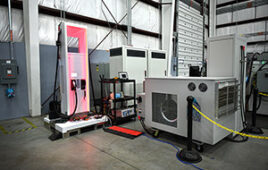Study describes health effects of occupational exposures in Paducah Gaseous Diffusion Plant workers
A five-year study into the causes of deaths of workers at Paducah Gaseous Diffusion Plant (PGDP) shows significantly lower death rates from all causes and cancer in general when compared to the overall United States population. This is known by occupational health researchers as the “healthy worker effect”. However, death from lymphatic and bone marrow cancers such as leukemia or multiple myeloma were slightly above national rates.
The study was conducted by faculty at the University of Louisville School of Public Health and Information Sciences and collaborators from the University of Cincinnati and the University of Kentucky. It was funded through the National Institute for Occupational Safety and Health, thanks to the effort of U.S. Senator Mitch McConnell, who was instrumental in getting the study off the ground.
“This was an important study, because it addressed lingering concerns about the health of workers at the Paducah Gaseous Diffusion Plant,” said David Tollerud, MD, MPH, professor of environmental and occupational health sciences at UofL’s School of Public Health and Information Sciences. “It is important for occupational health and public health research to attempt to answer pressing concerns of impacted populations, and we were able to report that we didn’t find unexpectedly high rates of disease in this workforce.”
Security workers had higher overall death rates than other employees, while chemical operators had higher death rates from leukemia and multiple myeloma than the rest of the workers.
“The increased number of lymphatic and bone marrow cancer deaths is consistent with what we expected. Based on other studies, these forms of cancer have been linked to low levels of radiation exposure,” Tollerud said.
The team compiled data on thousands of employees who worked at the plant for at least 30 days in different job classifications from 1952 through 2003. The data were used to assess exposure levels. Overall, 1,638 workers died out of the 6,759 in the study. This is less than the 2,253 deaths that would have been expected in the general public during the same time.
The team now plans to present its findings to PGDP workers and distribute a study fact sheet that summarizes the main findings and directs workers to resources that are available if they have concerns or questions.
The Paducah Gaseous Diffusion Plant, located in western Kentucky, is the only operating uranium enrichment facility in the United States, and the only one where a worker mortality study had not been conducted. The plant was commissioned in 1952 under the U.S. Department of Energy as part of a U.S. government program to produce enriched uranium to fuel military reactors and nuclear weapons. The plant’s mission changed in the 1960s from enriching uranium for nuclear weapons to enriching uranium for use in commercial nuclear reactors to generate electricity.




